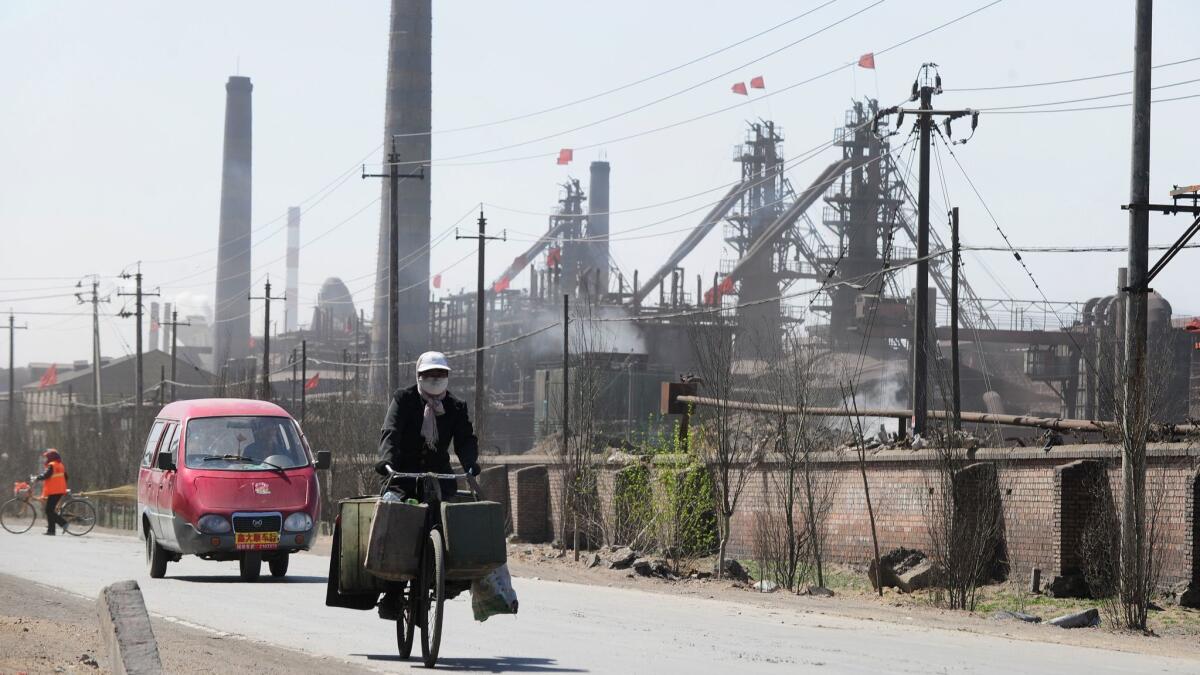China gears up to use rare earths as a weapon in trade war as summit approaches

Beijing is readying to use its dominance of rare earths to hit back in its deepening trade war with Washington.
A flurry of Chinese media reports on Wednesday, including an editorial in the flagship newspaper of the Communist Party, raised the prospect of Beijing cutting exports of the commodities that are critical in defense, energy, electronics and automobile sectors.
The worldâs biggest producer, China supplies about 80% of U.S. imports of rare earths, which are used in a host of applications including smartphones, electric vehicles and wind turbines. And most of the rare earths mined outside China still end up there for processing â even the sole U.S. mine at Mountain Pass in California sends its material to the nation.
The Department of Defense accounts for about 1% of total U.S. consumption of rare earths, according to a 2016 report from the U.S. Government Accountability Office. Still, ârare earths are essential to the production, sustainment, and operation of U.S. military equipment. Reliable access to the necessary material, regardless of the overall level of defense demand, is a bedrock requirement for DOD,â the GAO said in the report.
Rare earths have already featured in the trade dispute. The Asian country raised tariffs to 25% from 10% on imports from Americaâs sole producer, while the U.S. excluded the elements from its own list of prospective tariffs on roughly $300 billion worth of Chinese goods to be targeted in its next wave of measures.
âChina and rare earths is a bit like France and wine â France will sell you the bottle of wine, but it doesnât really want to sell you the grapes,â said Dudley Kingsnorth, an industry advisor and Perth-based executive director at Industrial Minerals Co. of Australia.
The strategy is intended to encourage end users like Apple Inc., General Motors Co. and Toyota Motor Corp. to add manufacturing capacity in China. It also means that Beijingâs threat to employ its dominance of rare earths threatens serious disruption to U.S. industry, by starving manufacturers of components commonplace in items that include cars and dishwashers. Itâs a stranglehold that might take years to break.
âThe development of alternative rare earth supplies is not something that can occur overnight,â said George Bauk, chief executive officer of Northern Minerals Ltd., which produces rare earths carbonate, a preliminary product, from a pilot plant in Western Australia. âThere will be a lag time for the development of any new projects.â
Each U.S. F-35 Lightning II aircraft â considered one of the worldâs most sophisticated, maneuverable and stealthy fighter jets â requires approximately 920 pounds of rare-earth materials, according to a 2013 report from the U.S. Congressional Research Service. Itâs the Pentagonâs most expensive weapons system and the first fighter designed to serve three branches of the U.S. military.
Rare earths including yttrium and terbium are used for laser targeting and weapons in Future Combat Systems vehicles, according to the Congressional Research Service report. Other uses are for Stryker armored fighting vehicles, Predator drones and Tomahawk cruise missiles.
The Pentagon didnât immediately respond when asked about the issue.
The threat to weaponize strategic materials ratchets up the tension between the worldâs two biggest economies before an expected meeting between Presidents Xi Jinping and Donald Trump at the G-20 meeting next month. It shows how China is weighing its options after the U.S. blacklisted Huawei Technologies Co., cutting off the supply of American components it needs to make its smartphones and networking gear.
âChina, as the dominant producer of rare earths, has shown in the past that it can use rare earths as a bargaining chip when it comes to multilateral negotiations,â said Bauk.
A case in point is the last time Beijing used rare earths as a political weapon. In 2010, it blocked exports to Japan after a maritime dispute, and while the consequent spike in prices saw a flurry of activity to secure supplies elsewhere â and a case brought to the World Trade Organization â nearly a decade later the nation is still the worldâs dominant supplier.
There is no such thing as an automobile sold in the U.S. or made in the U.S. that doesnât have rare-earth permanent magnet motors somewhere in its assembly.
— Jack Lifton, Technology Metals Research LLC
The U.S. shouldnât underestimate Chinaâs ability to fight the trade war, the Peopleâs Daily said in an editorial Wednesday that used some historically significant language on the weight of Chinaâs intent.
The newspaperâs commentary included a rare Chinese phrase that means âdonât say I didnât warn you.â The specific wording was used by the paper in 1962 before China went to war with India, and âthose familiar with Chinese diplomatic language know the weight of this phrase,â the Global Times, a newspaper affiliated with the Communist Party, said in an article in April. It was also used before conflict broke out between China and Vietnam in 1979.
On rare earths specifically, the Peopleâs Daily said it isnât hard to answer the question whether China will use the elements as retaliation in the trade war. Editorials in the Global Times and Shanghai Securities News took similar tacks in their Wednesday editions.
China could wreak maximum havoc by squeezing supplies of the magnets and motors that use the elements, said Jack Lifton, co-founder of Technology Metals Research LLC, whoâs been involved with rare earths since 1962. The effect on American industry could be âdevastating,â he said.
For example, rare-earth permanent magnets are used in miniature motors or generators in many, now ubiquitous, technologies. In a car, they allow windshield wipers, electric windows and power steering to function. And China accounts for as much as 95% of world output, according to Industrial Minerals Co.
âThere is no such thing as an automobile sold in the U.S. or made in the U.S. that doesnât have rare-earth permanent magnet motors somewhere in its assembly,â Lifton said. âIt would be a tremendous hit to the consumer appliance industry and the automotive industry. That means washing machines, vacuum cleaners, cars. The list is endless.â
The collection of 17 elements, which includes neodymium, used in magnets, and ytrrium for electronics, is actually quite abundant in the Earthâs crust, but mineable concentrations are less common than other ores. In terms of processing, Chinaâs capacity is already about double existing global demand, Kingsnorth said, making it more difficult for foreign companies to enter and compete in the supply chain.
Chinaâs rare earth market is dominated by a handful of producers including China Northern Rare Earth Group, Minmetals Rare Earth Co., Xiamen Tungsten Co. and Chinalco Rare Earth & Metals Co.
Chinaâs stranglehold is so strong that the U.S. joined with other nations earlier this decade in a World Trade Organization case to force the nation to export more amid a global shortage. The WTO ruled in favor of America, while prices eventually slumped as manufacturers turned to alternatives.
In December 2017, Trump signed an executive order to reduce the countryâs dependence on external sources of critical minerals, including rare earths, which was aimed at reducing U.S. vulnerability to supply disruptions. But industry veteran Lifton said the move wonât lessen the countryâs vulnerability any time soon.
âEven if the U.S. government said they were going to fund the supply chain, it would take years,â he said. âYou canât just say, âIâm going to build a mine, Iâm going to make a separation plant, and a magnet or metals facility.â You have to design them, build them, test them, and that doesnât happen in five minutes.â
Rogers, Stringer and Ritchie write for Bloomberg.
Rare but everywhere
Rare-earth elements have widespread uses in defense, energy and technology
Scandium: Light alloys for the aerospace industry, as a radioactive tracer and in lamps.
Lanthanum: High refractive index glass, camera lenses and catalysts.
Cerium: Used to give a yellow color to glass, as a catalyst, as a polishing powder and to make flints.
Praseodymium: Lasers, arc lighting, magnets, flint steel, and as a glass colorant, in high-strength metals found in aircraft engines and in flint for starting fires.
Neodymium: Some of the strongest permanent magnets available; used to give violet color to glass and ceramics, in lasers, capacitors and electric motor discs.
Promethium: The only naturally radioactive rare-earth element. Used in luminous paint and nuclear batteries.
Samarium: Lasers, magnets, masers, nuclear reactor control rods.
Europium: Used to prepare red and blue phosphors (marks on euro notes that prevent counterfeiting,) in lasers, in fluorescent.
Gadolinium: Lasers, X-ray tubes, computer memory, high refractive index glass.
Terbium: Used in green phosphors, magnets, lasers, fluorescent lamps, magnetostrictive alloys and sonar systems.
Ytrrium: Used in yttrium aluminium garnet (YAG) lasers, as a red phosphor, in superconductors, in fluorescent tubes, in LEDs and as a cancer treatment.
Dysprosium: Permanent rare earth magnets; lasers and commercial lighting; hard computer discs and other electronics; nuclear reactors and modern, energy-efficient vehicles
Holmium: Use in lasers, magnets, and calibration of spectrophotometers can be used in nuclear control rods and microwave equipment
Erbium: Vanadium steel, infrared lasers and fiberoptics lasers, including some used for medical purposes.
Thulium: One of the least abundant rare earths. Used in lasers, metal halide lamps and portable X-ray machines.
Ytterbium: Healthcare applications, including in certain cancer treatments; stainless steel and for monitoring effects of earthquakes, explosions.
Lutetium: Positron emission tomography (PET) scans, high refractive index glass, catalysts and LEDs.
Source: Bank of America Merrill Lynch, USGS
More to Read
Inside the business of entertainment
The Wide Shot brings you news, analysis and insights on everything from streaming wars to production â and what it all means for the future.
You may occasionally receive promotional content from the Los Angeles Times.










